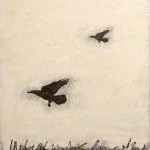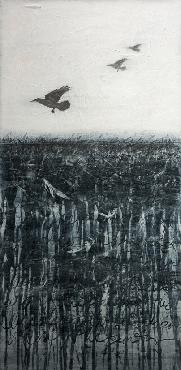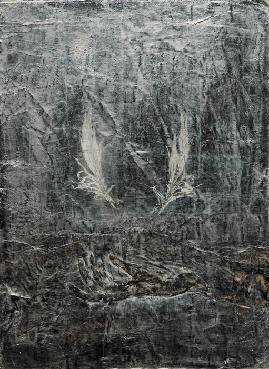Landscapes of Loss and Transformation
Christina Schmid reflects on "The Presence of Loss" a new collaborative exhibition at Form + Content pairing visual art by Camille Gage and poetry from Juliet Patterson along with a diverse body of community voices, all exploring the terrain of loss.

Loss always comes unbidden. It is a profoundly involuntary experience; we do not choose to lose someone, or something, that we care about. How are we to come to terms with this experience that has been forced on us? In the light of loss, our lives turn strange and incomprehensible. Grief takes time. Re-arranging a life around what’s newly missing may last longer than we realize. We take refuge in memories, in images and words that seem to preserve what has been lost. We learn how to live with an absence whose phantom pains haunt us. Compulsively, we circle around the conspicuous absence, not daring to look it in the eye, for fear that it might become all-consuming. Yet we cannot help but look for traces, remnants, possible explanations.
The paintings and poetry in The Presence of Loss circle around this central experience, exploring nuances of feeling loss, reacting to loss, and moving from an isolated, individual grief to a shared practice of remembering, recognizing, and honoring the presence of loss in our lives. Following poet Juliet Patterson’s words around the walls, we encounter meditative, many-layered paintings with recurring motifs: crows, black cut-out looking shapes in thick white skies, and pale feathers, hidden in dense layers of illegible handwriting. Motifs recur just as we, in grieving, are compelled to return, over and over, to the pain before eventually moving on.
In a culture that tells us, quite adamantly, not to cry over spilt milk, how are we to cope with loss? In a culture that leaves the care of emotional problems to therapists and pharmacologists, how are we to relate everyday to those who have lost, with empathy, not pity, and with respect that fosters dignity rather than a curt imperative to get a grip and move on?
Camille Gage’s paintings do not allow us to move on. The thick layers of paint bear testimony to the long, slow process of applying one coat of paint over the next. These paintings took time, insisted on taking that time to create stark contrasts between pale skies over dark horizons. Yet in these landscapes of loss the contrasts between black and white, presence and absence, either/or are misleading: there is no solid ground to stand on, only layers of handwriting, illegible, that enter into a curious dialogue with the careful lettering of the poetry on the walls. The skies offer no airy respite from the dark traces that offer us our only footing; the thick coat of impenetrable white muffles our senses and insulates us. There is nothing to fill this viscous void. Even the crows, harbingers of movement and the possibility of change to come, hang suspended, oddly solid, in the heavy whiteness. Curiously though, the longer we linger, the more shades emerge from the black and white, along with textures that suggest depth and time, nuances of experience and subtleties of change that may seem impossible at first in a black and white world, where there can only be either absence or presence.


Deceptively empty, these paintings only hint at the depth of experience hidden in the convoluted lines of black, the layers and textures of white, and at the immensity of what we stand to lose. Gage does not stop at contemplating the experience of personal loss visually but asks us to consider loss more literally, by painting the remains of lost species stored in the British National Museum. Physically set apart from the other, more metaphorical paintings, these seven paintings depict extinct species in layers of mostly white and thus serve as a pictorial testimony to a loss too immense to fully comprehend. Yet does this kind of irretrievable loss trigger the same reaction as personal loss? Hardly. The experience lacks the poignant intimacy of personal loss.
The centerpiece of The Presence of Loss is airy and light in a way none of the paintings strives to be. A long, rectangular strip of transparent, white fabric flows down from the ceiling, embroidered with hundreds of words that name something that has been lost. The words themselves signal the absence they name. As in quilting bees of old, the labor of many hands gives voice to individual losses that thus become shared experiences, as the stitches trace what has been lost, remembered, and put together on this sheer piece of fabric. As a token of collaborative acts of remembering, the embroidered words cast shadows while the piece of fabric moves gently in the artificial breeze generated by a ceiling fan.
Collaboration, too, becomes a sign for something else here: namely, the possibility of coping with loss through sharing it with others, by collectively remembering and honoring what has been lost. It is not unimportant, then, that a poet and a painter worked together here, combining pictorial and linguistic meditations on loss.
Yet this suggestion of sharing the loss, the grieving, and everything that comes after, is not the most radical one The Presence of Loss makes. As the artists put it, we’re interested not only in grieving and the darker side of loss, but also the transformative potential inherent in loss, and the personal and cultural opportunities loss presents for catalytic change and a refined understanding of both self and community. Here, then, is a different way of viewing loss: it can present an opportunity for transformation, heightened understanding, and bears the possibility of liberation and re-invention. Any sort of loss bears the seeds of becoming, of emergence. In this light, a painting such as Red Seed, Rooting becomes more than a testament of a lost species of plant: it obstinately demands that we see possibility here as well. So, as we shed the muffling layers of grief one by one, something else becomes visible if not quite tangible tinged by pain and, perhaps, colored by memories, but something not visible before.
These signs of transformation, of shedding the suffocating heaviness that comes with loss, appear in symbolic, quasi-mythical form in Gage’s paintings: feathers, lost, become feathers shed in an ongoing cycle of regeneration. Antlers appear suspended in the unyielding whiteness of the skies, oddly stationary and apparition-like, but indicative of a recurring process of shedding and growth, loss and renewal. These symbols from the natural world – feathers, fossils, seeds, antlers – remind us of the many cycles of loss and renewal we are surrounded by and part of. We may not carebut then, we may also take solace in the knowledge that our experiences and lives follow those same generational if not annual cycles.
As we complete the circle in form + content’s small but beautiful space, following the words along the walls and noticing the subtle changes in textures, composition, and motifs in the progression of paintings, we encounter a small, almost all black painting. While the very last painting in the circular arrangement takes us back to the already familiar motif of a number of crows hovering in an oppressive white sky over a tangle of black lines, the small, black, next-to-last painting contains little white; in fact, it is the only one of the black-and-white series which does not offer us a jagged horizon topped by a pale sky. Instead, a hand, turned upward, barely emerges from the black, as if to receive the white, fragile looking feather that seems to be drifting downward towards it. This image, more than any other, evokes the sense of graciously welcoming the traces and memories, the shed feather that will help keep our memories alive. Significantly, the thick, stifling coats of white have disappeared in this image. What remains at the near-end of this circle is a small square of darkness -the loss cannot be undone- but it can be transformed into a comforting darkness that allows us to embrace, accept, and recognize the transformation the presence of loss can bring about. We pause, we turn, and finally dare to look the presence of loss in the eye.
Related events: Thursday, February 28, 2008 at 7:00 pm
Community dialogue with poetry reading by Juliet Patterson
Where: Form + Content Gallery
Whitney Square Building
210 North 2nd Street, Suite 104
Minneapolis, MN 55401
Community dialogue and workshop sponsored by mnartists.org
When: Thursday, February 21, 2008 at 7:00 pm
Where: Walker Art Center, Star Tribune Foundation Art Lab, 1750 Hennepin Avenue, Minneapolis.
Info: www.walkerart.org
Reservations are required. Call 612/375-7600.
All events are free and open to the public.